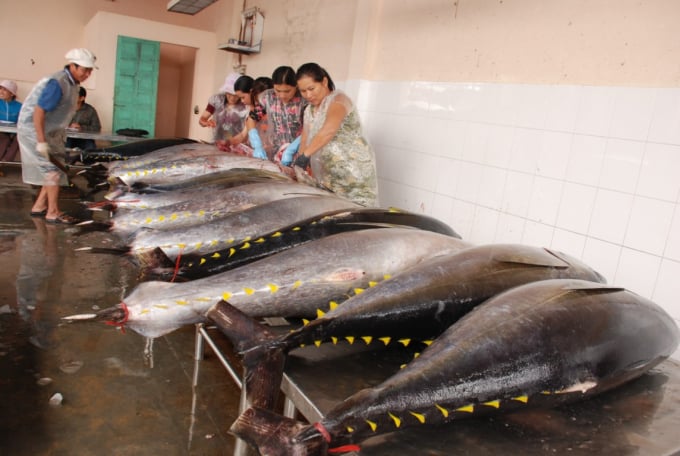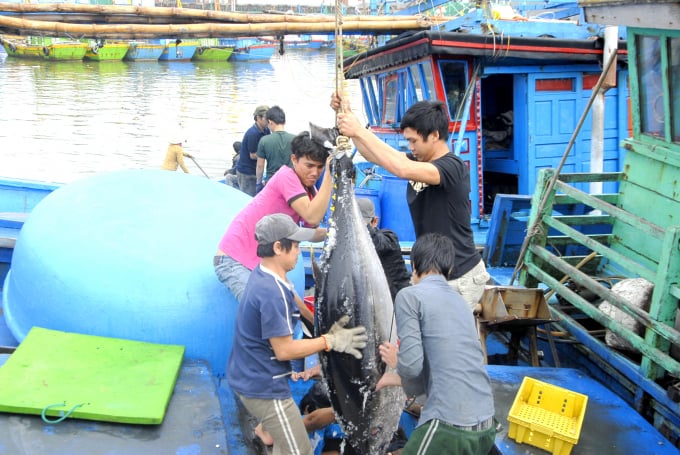November 21, 2025 | 02:48 GMT +7
November 21, 2025 | 02:48 GMT +7
Hotline: 0913.378.918
November 21, 2025 | 02:48 GMT +7
Hotline: 0913.378.918

The application of nano bubble technology in post-harvest preservation of tuna helps to improve quality and meet export requirements. Photo: V.D.T.
Binh Dinh's agricultural sector focuses on investing in the fisheries sector and improving the quality of tuna to meet export requirements for the period of 2021-2025.
Accordingly, Binh Dinh Department of Fisheries has coordinated with the Provincial Agricultural Extension Center to establish a pilot model of nano-bubble technology in post-harvest tuna preservation.
Binh Dinh Department of Fisheries coordinated with Binh Dinh Agricultural Extension Center to select qualified fishing vessels suitable for a model of tuna preservation using nano-bubble technology. 30 fishing vessels will be selected for pilot implementation, each fishing vessel will be supported 40% of the cost, equivalent to 40 million VND as investment in the engine system and storage tunnel. The functional sector will select 2 fishing vessels to implement this model in the second quarter of 2022. The sector will provide technical instructions, and transfer nanobubble technology to fishermen.
According to Binh Dinh Department of Fisheries, the province's ocean tuna fishing vessels currently use multiple modern equipment and technologies to preserve post-harvesting products including: Tuna Shocker pulse generator to incapacitate fish, discharging secretions and removing organs to preserve fish, etc. As a result, the quality of fish has been higher. Additionally, the introduction of nano bubble technology into the preservation stage helps fishermen raise the quality of fish further.
Fisherman Nguyen Van Trang, owner of an ocean tuna fishing vessel in Tam Quan Bac ward (Hoai Nhon town, Binh Dinh) said that nano bubble technology in preservation helped fishermen preserve ocean tuna for longer, maintaining a better freshness.
This technology requires fish storage cellars to be adjusted following an appropriate design. The fish is preserved by vertical hooks in the cellar to save space as well as the time spent loading and unloading fish ashore. Fish preserved following this technology will consistently reach grade A, which leads to higher selling prices, and an increase in profit per trip.
"After investing in nano bubble technology to preserve post-harvest products, the quality of our tuna will certainly meet the export requirements, and fishermen can participate in product consumption chains to stabilize output", Mr. Trang shared.

Preservation of ocean tuna following traditional methods yields low-quality fish, which then can only be sold in the market at a low price. Photo : V.D.T.
Mr. Tran Van Vinh, Deputy Director of Binh Dinh Department of Fisheries, nano air bubbles will retain contaminated parts so the final product will be cleaner with a better quality. Nano bubble technology can be simplified as a water purifier that produces small water molecules, these microscopic water molecules will then quickly penetrate the fish and preserve it rapidly. In addition, nano bubble technology uses nitrogen to aerate, so contaminated particles are pushed to the top, keeping the product clean. “When the microscopic water molecules penetrate quickly and deeply into the fish, the product will be fresh from the inside out, avoiding the decomposition process that reduces the quality of the fish.

The application of nano bubble technology in post-harvest preservation of tuna through the use of vertical hooks also saves the effort of bringing the fish out of the cellar. Photo: V.D.T.
According to Mr. Tran Van Phuc, Director of Binh Dinh Department of Agriculture and Rural Development, the application of nano bubble technology in post-harvest ocean tuna helps fishermen improve product quality, the price will consequently increase, income per trip will be higher, especially in the context that fishing grounds are losing aquatic resources while fuel prices are skyrocketing.
Each offshore fishing trip usually lasts over 20 days, preservation of tuna following the traditional method reduces the quality and the price of the fish. Meanwhile, grade A fish are more common when applying nano bubble technology, selling prices increase by 10 to 15% compared to the mass market price, fishermen's profit also increases as a result.
"The technical transfer of tuna preservation using nano-bubble technology helps fishermen develop responsible fisheries gradually. Participating fishermen are informed and guided by specialized agencies; ensuring the process from catching to preserving. Once the quality of fish is guaranteed, fishermen can participate in production consumption chains”, said Mr. Tran Van Phuc.
Translated by Nguyen Hai Long

(VAN) This is the study conducted by IRRI and Can Tho University on the rice straw value chain in Mekong Delta showing an economic potential of more than 6.6 trillion VND/year.

(VAN) By participating in cooperative economics, many farmers in Tay Ninh have overcome hardship, mastered clean dragon fruit cultivation techniques.

(VAN) The crossbreeding program in the former Binh Dinh province (now part of Gia Lai) has shown signs of decline, and urgent measures are needed to revive it and sustain past achievements.

(VAN) The agricultural sector agreed on a roadmap to pilot the MRV protocol and expand low-emission rice production from the 2025-2026 winter-spring crop.

(VAN) Agricultural extension officers in Quang Ninh do more than transmit knowledge; they have become a steadfast support system for farmers on the path to sustainable agricultural development.

(VAN) The development of a high-quality beef cattle herd has brought major benefits to livestock farmers, creating jobs and enabling better use of agricultural by-products.

(VAN) In the eastern region of Gia Lai, crossbred cattle now account for 93%, forming a high-quality beef herd and establishing a recognized brand, the result of 35 years of persistent effort.